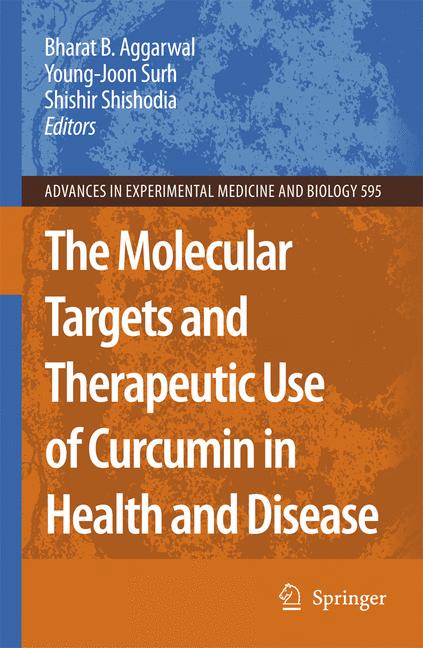| Chapter title |
Molecular targets of curcumin.
|
|---|---|
| Chapter number | 10 |
| Book title |
The Molecular Targets and Therapeutic Uses of Curcumin in Health and Disease
|
| Published in |
Advances in experimental medicine and biology, June 2007
|
| DOI | 10.1007/978-0-387-46401-5_10 |
| Pubmed ID | |
| Book ISBNs |
978-0-387-46400-8, 978-0-387-46401-5
|
| Authors |
Lin JK, Jen-Kun Lin, Lin, Jen-Kun |
| Editors |
Bharat B. Aggarwal Ph.D., Young-Joon Surh Ph.D., Shishir Shishodia Ph.D. |
| Abstract |
Curcumin possesses anti-inflammatory activity and is a potent inhibitor of reactive-oxygen-generating enzymes such as lipoxygenase/cyclooxygenase, xanthine dehydrogenase/oxidase, and inducible nitric oxide synthase (iNOS); it is an effective inducer of heme oxygenase-1. Curcumin is also a potent inhibitor of protein kinase C (PKC), EGF-receptor tyrosine kinase, and IkappaB kinase. Subsequently, curcumin inhibits the activation of NF-KB and the expressions of oncogenes including c-jun, c-fos, c-myc, NIK, MAPKs, ERK, ELK, PI3K, Akt, CDKs, and iNOS. It is considered that PKC, mTOR, and EGFR tyrosine kinase are the major upstream molecular targest for curcumin intervention, whereas the nuclear oncogenes such as c-jun, c-fos, c-myc, CDKs, FAS, and iNOS might act as downstream molecular targets for curcumin actions. It is proposed that curcumin might suppress tumor promotion through blocking signal transduction pathways in the target cells. The oxidant tumor promoter TPA activates PKC by reacting with zinc thiolates present within the regulatory domain, whereas the oxidized form of cancer chemopreventive agent such as curcumin can inactivate PKC by oxidizing the vicinal thiols present within the catalytic domain. Recent studies indicated that proteasome-mediated degradation of cell proteins play a pivotal role in the regulation of several basic cellular processes, including differentiation, proliferation, cell cycling, and apoptosis. It has been demonstrated that curcumin-induced apoptosis is mediated through the impairment of the ubiquitin-proteasome pathway. |
X Demographics
Geographical breakdown
| Country | Count | As % |
|---|---|---|
| United States | 1 | 100% |
Demographic breakdown
| Type | Count | As % |
|---|---|---|
| Scientists | 1 | 100% |
Mendeley readers
Geographical breakdown
| Country | Count | As % |
|---|---|---|
| United Kingdom | 1 | <1% |
| Luxembourg | 1 | <1% |
| Unknown | 131 | 98% |
Demographic breakdown
| Readers by professional status | Count | As % |
|---|---|---|
| Student > Master | 29 | 22% |
| Student > Ph. D. Student | 23 | 17% |
| Student > Bachelor | 18 | 14% |
| Researcher | 17 | 13% |
| Other | 6 | 5% |
| Other | 19 | 14% |
| Unknown | 21 | 16% |
| Readers by discipline | Count | As % |
|---|---|---|
| Biochemistry, Genetics and Molecular Biology | 26 | 20% |
| Agricultural and Biological Sciences | 24 | 18% |
| Medicine and Dentistry | 14 | 11% |
| Chemistry | 14 | 11% |
| Pharmacology, Toxicology and Pharmaceutical Science | 9 | 7% |
| Other | 17 | 13% |
| Unknown | 29 | 22% |
